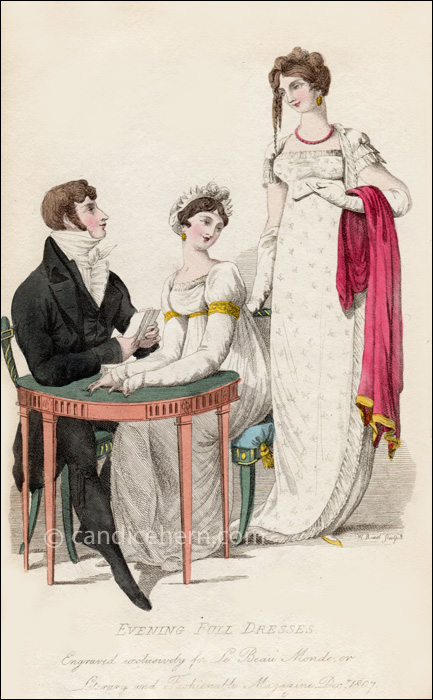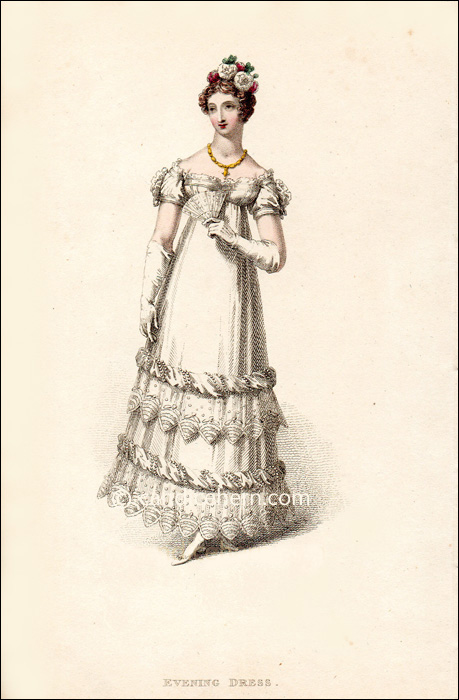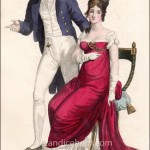Le Beau Monde, December 1807.
“Evening Full Dresses.”
The three figures seem to be at a card party, which would not typically require Full Dress, but so their fashions are described.
The model in the center wears long sleeves that are puffed at the top with a thick band of gold foil. It looks as though the long sleeves might be detachable, even though they are not described as such.
As typical of this magazine, the description of the male in full dress (Fig. 1) is quite general and not necessarily specific to the figure represented in the print.
The very detailed descriptions of the female fashions lead me to believe that they might have been written by the famous Mrs. Bell. The publisher of this magazine, John Browne Bell, was her husband. Bell sold Le Beau Monde in 1809, and it ceased publication entirely a year later. Mrs. Bell’s designs, and effusive descriptions of them, began to appear in her father-in-law’s magazine, La Belle Assemblée, shortly thereafter.
The print is signed by the engraver, William Read, a popular London engraver from the early 19th century through the 1840s.
The print is described in the magazine as follows:
“Fig. No. 1.–Evening Dress is invariably black. The coats have constantly collars of the same cloth, and covered buttons; black kerseymere waistcoat and breeches are considered genteel; black silk is necessary in dress parties.
“Fig. No. 2.–A round dress of soft white satin enriched round the bottom with a border of gold foil; the back and front of the dress is made square and low, with a broad lace tucker across the bosom and back, leaving the shoulder straps quite plain; the sleeves are made full on the shoulder, and continues to the wrist, trimmed round the hand with a narrow lace to correspond with the bosom of the dress; the sleeves are separated round the thick part of the arm above the elbow, with a rich band of gold foil; the body and skirt are also gathered into a band of the same around the waist; the Wyndham cap, formed alternately into waves of white satin and lace, finished round the front with a superb Vandyke lace; a small band of satin round the crown, with a full bunch of white satin roses intermixed with leaves of white satin in front, inclining to the left side of the head; the hair is combed in loose waves and worn back off the right side above the eyebrows, and parted in the center of the forehead; bracelets of white cornelian, gloves and shoes of white kid.
“Fig. No. 3.–A demi-robe of white Albany gauze over a soft white figured satin train petticoat; the dress is made complete in one; wraps straight over the bosom to the left side; and is gradually sloped off round the train; a loose robing of rich white lace, fastened in the center of the back, and is drawn down to the extremity of the waist, with a pearl clasp; the lace continues to cross the back, and is confined on the top of the left shoulder with a rosette of lace; the dress is trimmed all round with a deep Brussels lace; a full puff sleeve at the top of the shoulder; with two rows of lace gathered full round the arm, one above the other, to correspond with the dress; the hair in a plain band on the left side of the forehead, with a few loose waves on the other; two large corkscrew curls, falling from the front of the right side of the head towards the shoulder; with coronet combs of pearls to secure the hair behind in separate forms. A rich Barcelona scarf, trimmed with a narrow border of gold all round, hanging negligently over the arm; necklace and ear-rings of cornelian; French kid gloves, and yellow satin shoes.”








